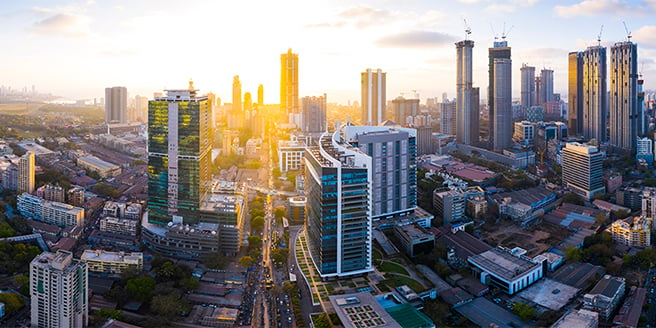There was a time when “commercial” meant Nariman Point or BKC. For decades, the heart of Mumbai’s business pulse beat in the crowded veins of the island city. But quietly, strategically, and almost poetically, that heart has found a new rhythm — in Navi Mumbai.
And if you’re reading this, maybe you’re someone like me a few years ago — unsure whether this upcoming landscape was just hype or truly the future. Today, I’m going to share not just data, but my personal understanding and insights I wish someone had told me earlier. This isn’t just a blog. It’s a decoded map.
The Shift: From Overflow to Opportunity
As Mumbai grew denser, companies began looking outward. But they didn’t just need space. They needed infrastructure, affordability, connectivity, and most importantly — scalability. Navi Mumbai delivered on all counts:
- Wide roads, planned sectors, less congestion
- Massive infrastructure push (Metro, MTHL, upcoming Airport)
- Better rentals for larger spaces
- Easier compliance and cleaner governance zones
This was no longer a fallback. Navi Mumbai became a first choice.
📈 Real Proof: The Numbers Don’t Lie
If you follow trends like I do, you’ll know one thing: money moves first. And here’s where it has moved recently:
- ✅ Wipro leased 3.87 lakh sq.ft in Airoli (2025) for 10 years.
- ✅ Data centers now take up over 44% of India’s total capacity in Navi Mumbai.
- ✅ Office leasing has jumped across Airoli, Vashi, Belapur & Panvel in H1 2024 alone.
- ✅ The SEZ belts (Kalamboli, Ulwe, Dronagiri) have seen 60,000 crore+ investment inflow.
What started as promise is now performance.
Why Smart Investors Are Already Here
Whenever I talk to investors, I say this: Don’t wait for brochures. Follow cranes.
The number of commercial projects being built or redeveloped in Navi Mumbai is your real-time indicator. Tech parks in Airoli. Retail showrooms in Nerul. Warehousing in Taloja. Flexible offices in Vashi. And micro-commercials in Panvel gaining huge attention due to the Airport.
What they all have in common?
- Lower entry cost compared to Mumbai
- Faster rental absorption
- Growing tenant demand (especially IT, BFSI, Retail, Healthcare)
It’s the kind of market where every square foot tells a story of growth.
❓ Still Doubting Navi Mumbai? Here’s What Most People Fear (and Why It’s Wrong)
- “Is it too early to invest?” — The airport and metro are already in motion. Early movers always benefit the most.
- “Will I get tenants?” — The absorption rate in key nodes like Airoli and Vashi is above 90%.
- “Is resale possible?” — Commercial property is highly liquid in high-growth zones, especially if chosen wisely.
- “Is it just hype?” — Wipro, L&T, Mindspace and multiple MNCs aren’t investing based on hype. They read the future.
Real Story: A Small Step That Turned into a Commercial Leap
One of our clients, a young entrepreneur, started with a small retail shop in Nerul in 2021. By 2024, he expanded into a 2nd unit in Vashi — and today he’s leasing a full floor in Panvel, anticipating airport footfall. He started small, but chose his location like a pro.
Success isn’t about money. It’s about reading the map early.
Simple Framework to Evaluate Commercial Property (My Cheat Code)
When I started guiding commercial clients, I simplified my due diligence into what I now call the “C-A-R-E” framework:
C – Connectivity: Proximity to highways, stations, upcoming Metro or Airport? Time = Money.
A – Absorption: Are units being leased fast in this area or are projects sitting vacant?
R – Rental Yield: What is the average % yield vs price paid? Is it beating inflation?
E – End-User Demand: What kind of companies are moving in? IT? Retail? Healthcare? Warehousing?
Use CARE, and you’ll rarely go wrong.
Myths About Navi Mumbai Commercial Property That Are Costing You Opportunities
- “Commercial is only for big investors.” — You can start from 30-50L with micro-units in Panvel or Taloja.
- “It’s hard to manage.” — Many properties offer managed leasing with ready tenants.
- “Returns are slow.” — Yields in Vashi and Airoli are already crossing 7.5-8%.
- “There’s no resale market.” — Commercial resale is strong near infra projects.
- “Only retail or IT works.” — Warehousing, healthcare, F&B, and even co-working are booming.
Final Word: Why This Moment is Rare
The truth is: Navi Mumbai is no longer “upcoming”. It has arrived. But what makes 2025 truly rare is that supply still exists, and prices haven’t peaked yet. Once the Navi Mumbai International Airport goes live and Metro lines begin full operations, the price curve will tilt.
This is the window.
If you’re a business owner, investor, or dreamer who missed Mumbai in the 90s, or BKC in the 2000s — you don’t want to miss Navi Mumbai now.
Bonus: If I Had ₹50 Lakhs to Invest in 2025 — Here’s Exactly Where I’d Put It
If I had 50L today, I’d go for:
- Panvel micro-commercial: Near upcoming metro node or airport access road.
- Retail unit in Vashi: Near station footfall zone or within a mall.
- Small office in Airoli tech belt: Leverage IT demand and SEZ ecosystem.
Split smart. Entry is key.
✅ FAQs Based on What Most Investors Ask Us
Q: Is commercial property in Navi Mumbai a good investment in 2025?
A: Yes, because infra + demand + affordability = high growth.
Q: What kind of ROI can I expect?
A: Between 6.5% to 9% rental yields, depending on location and asset type.
Q: Which area is best: Vashi, Airoli, or Panvel?
A: Depends on your intent. Vashi = retail, Airoli = IT, Panvel = future growth + airport.
Q: What is better – to buy or lease?
A: If your horizon is 5+ years, buying in Navi Mumbai in 2025 makes great sense.
From one believer to another,
– Team Revaa Homes
Your Local Experts in Navi Mumbai Commercial Real Estate


